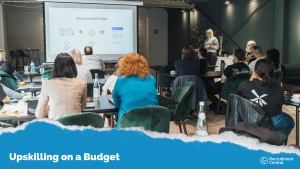5 Strategies That Work to Handle Rejection When You Didn’t Get the Role You Wanted explores how to cope when you don’t get the job you were hoping for and how to rebuild your confidence afterwards. If you’ve wondered how to stay motivated after job rejection or how to turn setbacks into progress, this guide walks you through simple, practical steps. You’ll learn how to manage emotions, use feedback wisely, and move forward with clarity and resilience.
You did everything right – custom resume and cover letter, did a strong interview, completed the assessment – but the answer was: “We’ve decided to move forward with another candidate.”
What You’ll Learn
- Process rejection without spiralling – practical self-compassion techniques to manage the emotional impact of hearing “no” and prevent anxiety from taking control
- Turn feedback into your advantage – how to ask for (and use) interviewer insights that 70% of managers are willing to share but only 30% of candidates request
- Build skills that matter now – why most employers prioritise demonstrable skills over credentials, and how to identify and close your specific gaps
- Leverage hidden job opportunities – strategies to access unadvertised roles through networking and relationship building
- Reframe setbacks as redirection – methods to maintain forward momentum and recognise when rejection is guiding you toward better-fit opportunities
In some industries, only 2% of job applicants get an interview, so the odds of being hired are extremely slim. Many employers are more selective now about who they bring on board.
There are plenty of reasons you might not be selected. Sometimes another candidate had more direct experience. Other times, the job goes to someone internal, or priorities shift quietly. You might never know. Most people don’t.
That uncertainty leaves space for self-doubt. It’s not just about missing an opportunity, it’s the feeling that your effort was wasted or that you weren’t as strong as you thought. That kind of thinking can wear you down, especially after multiple rejections.
So, here are five strategies to help you process rejection, stay confident, and take your next step without spiralling.
Strategy 1: Process the Emotional Impact and Practise Self-Compassion
Millions of people say it’s harder to get a job now than it used to be. But knowing that doesn’t always make rejection easier. Each “no” can fuel anxiety and chip away at motivation.
Around 72% of candidates say job searching affects their mental health. The best thing you can do is stop that negativity from taking control. That doesn’t mean ignoring how you feel.
There’s often pressure to move on quickly – to dust yourself off and apply for the next role. But it’s okay to pause. Not to quit, just to regain your balance. Take a walk. Put your phone down. Slow your thoughts.
If being still helps, try a short breathing exercise or an app like Headspace. If not, get moving – clean something, cook, or message a friend who helps you feel grounded.
Most importantly, listen to how you talk to yourself. Rejection can twist that inner voice into something harsh. Try keeping it simple:
- “It’s disappointing, but I still showed up.”
- “I answered honestly.”
- “This one wasn’t mine, but that doesn’t mean the next one won’t be.”
You may not get closure – most people don’t – but you can still move forward without dragging yourself down.
Strategy 2: Seek and Analyse Feedback for Growth
Rejection stings, but it’s also a chance to learn. If the role felt like a good fit, consider asking for feedback. You might get insight that helps next time.
According to LinkedIn’s hiring trends report, 70% of managers are open to sharing feedback, but only 30% of candidates ask for it. That’s a missed opportunity.
Reach out within a day or two of hearing back. Keep your message short and professional:
“Thanks again for the interview. I really enjoyed meeting you and learning more about the company. I’d be grateful for any feedback that could help me improve if you’re open to it. Even a sentence or two would be helpful.”
Not everyone will reply, but the ones who do can make a big difference. Over time, you’ll start to see patterns.
- Was it a technical gap?
- Were your examples too broad?
- Did similar questions trip you up more than once?
Some candidates track feedback in a short document, just notes about what was asked and how they responded. After a few interviews, the trends become clear.
Once you have feedback, put it to use. If your answers are often too general, practise tightening your examples. If you’re unsure where to start, a coach or mock interview with a peer can help. Focus on the things you hear more than once, that’s where the real growth happens.
Strategy 3: Use Rejection as a Skills Development Catalyst
Not getting the job might simply mean it wasn’t the right match. Or it could highlight a gap you can work on.
Many companies are hiring differently now. They’re less focused on job titles and more on skills. According to Forbes, 94% of employers say hiring for skills instead of degrees leads to better performance. It’s a shift that rewards adaptability, but it also raises expectations. The average lifespan of a hard skill is now around five years and shrinking.
If you keep seeing the same tools or systems listed in job ads and they’re unfamiliar, it’s worth paying attention. That doesn’t mean you need another degree; sometimes, a few hours of online learning or tutorials can help fill the gap.
As you grow your skills, think long-term. The World Economic Forum reports that 59% of workers will need retraining or redeployment this decade. Stay curious, stay adaptable, and keep learning, it will pay off.
Strategy 4: Leverage Rejection to Strengthen Your Professional Network
Rejection can also help you build your network. Many roles are filled through referrals or internal connections rather than job ads, what’s known as the hidden job market. The only way to tap into it is through genuine relationships.
Start by leaving a positive impression. Even if you didn’t get the job, send a short thank-you email to your interviewer. If it felt like a good connection, follow up with a LinkedIn request and a personal note.
Making contacts is one thing, maintaining them is another. You don’t need to be pushy, just stay visible.
- Join a LinkedIn group where people in your field share insights.
- Attend free webinars or panels – even if one isn’t great, someone attending might be worth meeting.
- Message an old colleague just to say hello.
- Reach out to someone you admire and ask for a quick chat, making it clear you’re not asking for a job.
- Follow companies you like and engage thoughtfully with their posts.
Stay connected with people who care about your success, mentors, peers, friends. You never know which relationship will lead to your next opportunity.
Strategy 5: Reframe Rejection as Redirection and Maintain Momentum
Rejection can feel like a closed door, but sometimes it’s the start of a new direction. Many people look back and see how not getting one role led them to something better.
That doesn’t mean you should ignore the disappointment. It just means viewing it as progress, another step forward, not a setback.
Keep your job search organised and consistent:
- Block out time for job search tasks, then stop when the time is up.
- Keep a list of where you’ve applied so you don’t double up.
- Set small goals, like three quality applications per week.
- Track small wins – a recruiter call, a new connection, useful feedback.
When motivation drops, return to the basics, rest, reset, and try again.
Sometimes multiple rejections can tell you something. Maybe the roles you’re chasing are too narrow or not quite aligned. Try widening your scope:
- Adjust your filters for location, seniority, or industry.
- Revisit roles you skipped before, what’s changed?
- Ask yourself what kind of team or purpose would energise you most.
You only need one offer, and it often comes after things haven’t gone as planned.
Every Rejection Takes You One Step Further
Rejection is a normal part of the job search. It’s not easy, but it’s familiar, and everyone experiences it. Whether this was your first or tenth setback, it doesn’t mean you’re falling behind, it means you’re in motion.
Each “no” offers something useful. Feedback shows where to grow. Reflection reveals your strengths. Skills can be sharpened, connections built, and direction realigned.
The five strategies, practising self-compassion, asking for feedback, building skills, staying connected, and reframing rejection as redirection, work best together. They don’t erase the sting, but they give you a path forward.
Keep going. Every application is a new chance, and every rejection brings you closer to the right opportunity. Persistence isn’t just showing up again, it’s showing up wiser, clearer, and ready.
Looking for extra support while navigating your job search?
Explore our Candidate Resources Hub for practical tools, templates, and career advice.
Refresh your materials with Updating Your Resume Made Easy, then stay motivated by subscribing for monthly insights, new roles, and job search tips here.
For more career and interview advice, visit this page.




















